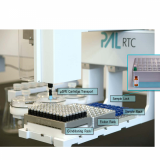Automated micro-SPE Clean-up of QuEChERS Extracts for Multi-Residue Pesticide Analysis
02-02-2017
Introduction
The extraction and clean-up of pesticides from food still raises particular challenges due to the high number and difference in chemical nature of the compounds embedded in food matrices of high complexity and highly varying compositions. Due to their polarity, molecular weight, sta-bility, or ionization characteristics compounds are detected by GC and LC separation typically using MS/MS or accurate mass instrumentation (Raina 2011; Scherbaum 2008).
In recent years the QuEChERS (Quick Easy Cheap Effective Rugged Safe) methodology (Anastassiades 2003) has been introduced in many food safety laboratories for pesticides. While the extraction step has been well standardized (AOAC 2007.1; CEN 15662) the clean-up of the resulting extracts still differs widely for different matrices and laborato-ries with the common goal to extend the GC, LC and MS maintenance cycles for increased productivity (Jiao 2016), and reducing matrix ef-fects. The potential for high sample throughput using the QuEChERS extraction is impeded by laborious maintenance work (Hildmann 2014; Stahnke 2012).
Analytical limitations of the dispersive SPE (dSPE) step used in the QuEChERS methodology with high matrix load resulting in poor clean-up of lipid-rich foods in particular. In consequence several matrix de-pendent clean-up strategies are found in literature to overcome ma-trix effects (Anastassiades 2013; Chamkasem 2013; Jiao 2016). “As for clean-up stage by dSPE, type and amount of sorbent and MgSO4 and their selectivity were the main problematic issues” (Rejczak 2015). With the versatility of the QuEChERS extraction step an equally matrix inde-pendent and robust clean-up solution for extracts is highly desirable.
« News overview
